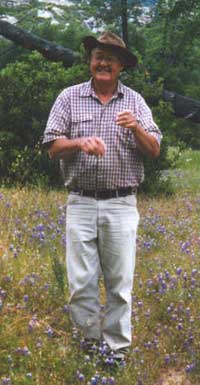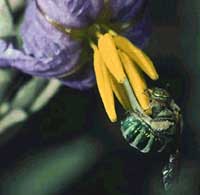The San Rafael Desert — 500 square miles of rolling gravel broken by an occasional butte or sandstone formation — certainly isn’t the prettiest place in eastern Utah. Dotted with cattle and exploratory oil rigs, it is a living example of the federal government’s policy of multiple use on public lands. For just about anybody driving along its western edge, the desert is an unremarkable preamble to the celebrated, rose-colored canyons of the neighboring San Rafael Swell.

Frank Parker, busy as a bee.
Photo: Olivia Messinger, USDA Bee Lab,
Utah State University, Logan.
But entomologist Frank Parker isn’t just anybody. The former head of the USDA Bee Lab in Logan, Utah, Parker has been called a “human vacuum cleaner” for his prowess in accumulating bees, among other things. “Frank is constantly collecting something,” sighs his long-time colleague and fellow entomologist, Vince Tepedino. “If not insects, then fish, or geese, or arrowheads, or bottles, or license plates, or potato mashers.”
The man Tepedino calls “Bring ‘Em Back on Pins” Parker pulled off into the San Rafael Desert one day in 1979 on his way back from a fishing trip with his sons. It didn’t take him long to realize the desert’s gravel swells harbored the richest diversity of new bee and wasp species he’d ever seen.
“I was flabbergasted!” said Parker, who eventually resigned his position at the bee lab (“It was mostly administrative”) in order to have more time for collecting. He did a stint in Costa Rica and is now collecting in South America. Prior to heading off on his current trip, he happily showed some visiting scorpion specialists around the San Rafael Desert.
Parker and other scientists from the bee lab put the San Rafael Desert on the biological map, collecting extensively in the area from 1979 until 1993. They discovered that one-third of the state’s bee species live in an area that covers 2 percent of the state. They found at least 333 bee species, 48 of which had never been described before and 68 of which are endemic. They also ran into a plethora of wasps.
“We had a good time,” recalls Parker.
Making a Beeline for the Desert
The scientists published descriptions. They dug nearly a dozen feet into a sand dune and discovered the deepest bee nest ever recorded in North America. A new species was found to nest in numerous tiny honeycomb-like holes in sandstone. “Once you recognize [the nests], you can see them when you go by,” exults Parker. “They’re huge! They’re probably 20 feet long.” Parker discovered a new species and named it Boharti after George “Ned” Bohart, the founder of the bee lab.
“It’s a neat place,” says Parker. “If you graph the amount of collecting effort we expended with the number of spoecies we recorded, you learn that there are likely to be many that we still have not found. We have a lot more work to do.”
One resident of the desert — Osmia sanrafaelae — has shown potential as a pollinator of commercial alfalfa. More research needs to be done before this species would be ready for release to growers, but it could ultimately prove valuable for agriculture. Millions of acres of U.S. crops are pollinated by honeybees, which were brought over from England by the Jamestown colonists nearly 400 years ago. Honeybee populations have been beset with problems in recent years, in part because of mites and herbicides used on crops, and alternative pollinators could be a real boon to farmers.
Terry Griswold, another entomologist who joined Parker on numerous collecting trips, hopes the desert’s biological riches will be appreciated whether or not they contribute to agricultural production or anyone’s bottom line. Biodiversity isn’t limited to undiscovered medicines yet to be extracted from the Amazon, he says. “It isn’t just the tropics. It isn’t just some new pharmaceutical,” Griswold says. “Hopefully we’ll come to believe that species have importance simply in the natural biota. But it always helps if you can put food in people’s mouths.”

A peppy polinator.
Photo: USDA Bee Lab,
Utah State University, Logan.
To Bee or Not to Bee?
Unhappily, the San Rafael Desert’s bee/flower communities are at risk. Much of the desert is open to off-road vehicles, which can crush bees’ nests. Scientists are even more concerned about exotic weeds that are starting to sweep into the area. Perhaps the most pernicious of these is a Eurasian plant called cheatgrass, which can turn native plant communities into monocultures with astonishing speed. Although cheatgrass has favored the more fertile soils of western Utah, it is spreading and adapting fast.
Some scientists say wilderness designation could protect the San Rafael Desert’s unique bee/flower communities. The Bureau of Land Management, which administers the San Rafael Desert, hasn’t included the area in the 5.7 million acres it’s studying for possible designation as wilderness. But the Utah Wilderness Coalition’s Citizen’s Proposal, which calls for 9.1 million acres of wilderness in the state, would protect many of the bees’ hangouts. Wilderness designation would prevent the construction of new roads, whose disturbed edges act as vectors for cheatgrass invasion, as well as prohibit ORVs and stop further oil and gas exploration.
Parker’s in favor of wilderness designation: “Definitely it should be protected,” he said. “That’s the only place they occur, 68 [endemic] species of bees, and I don’t know how many species of wasps. Where else are you going to find that?”


